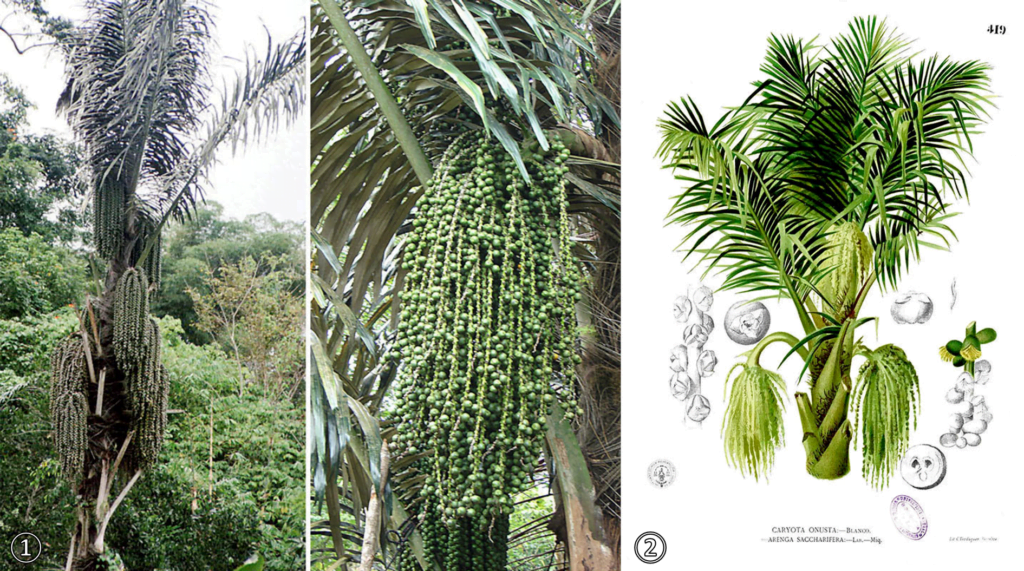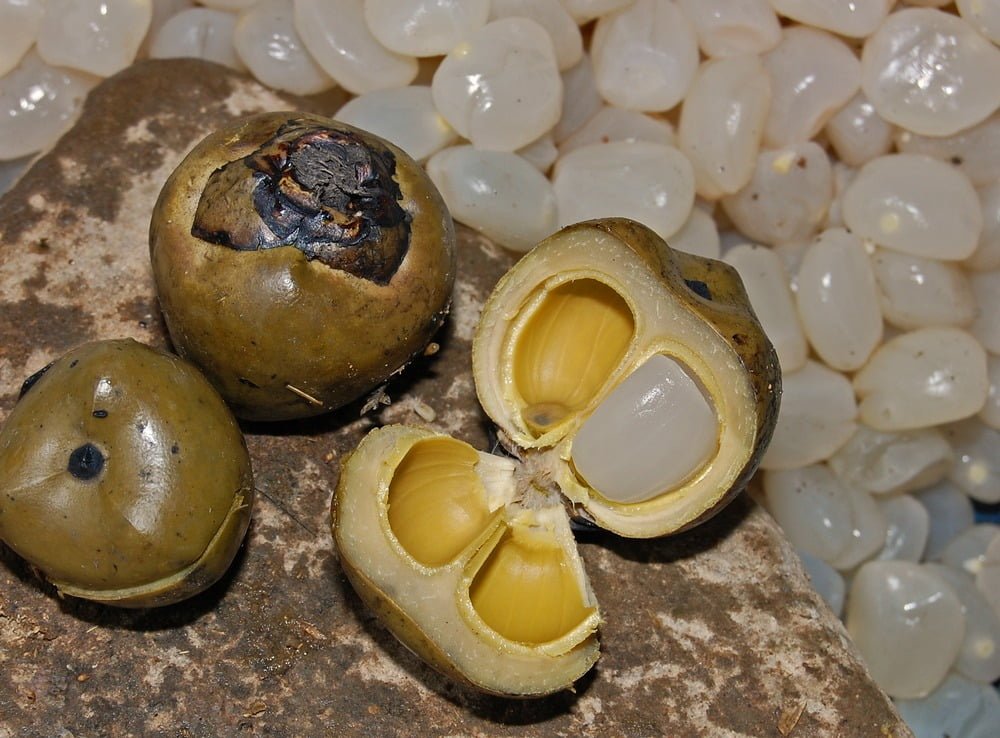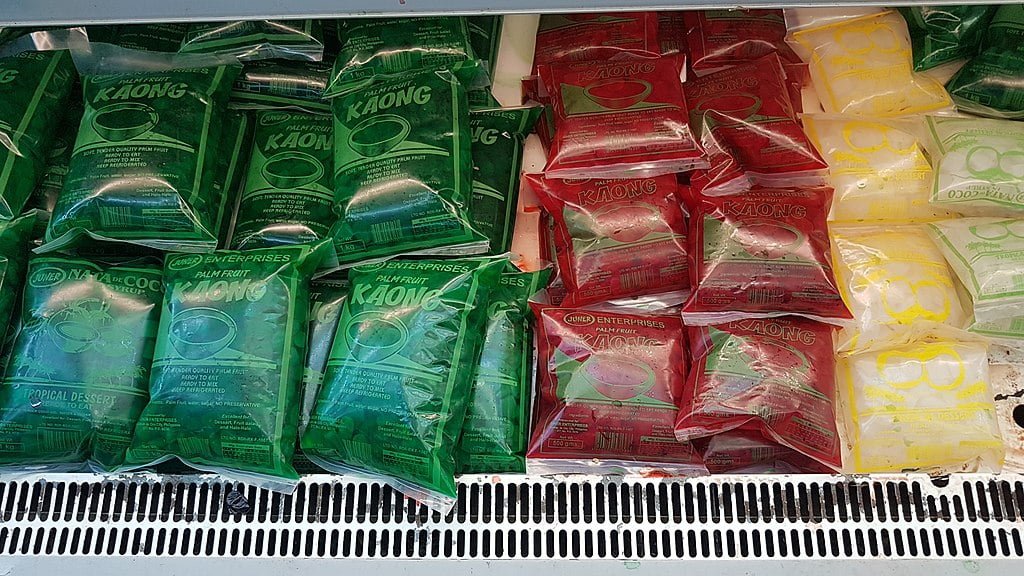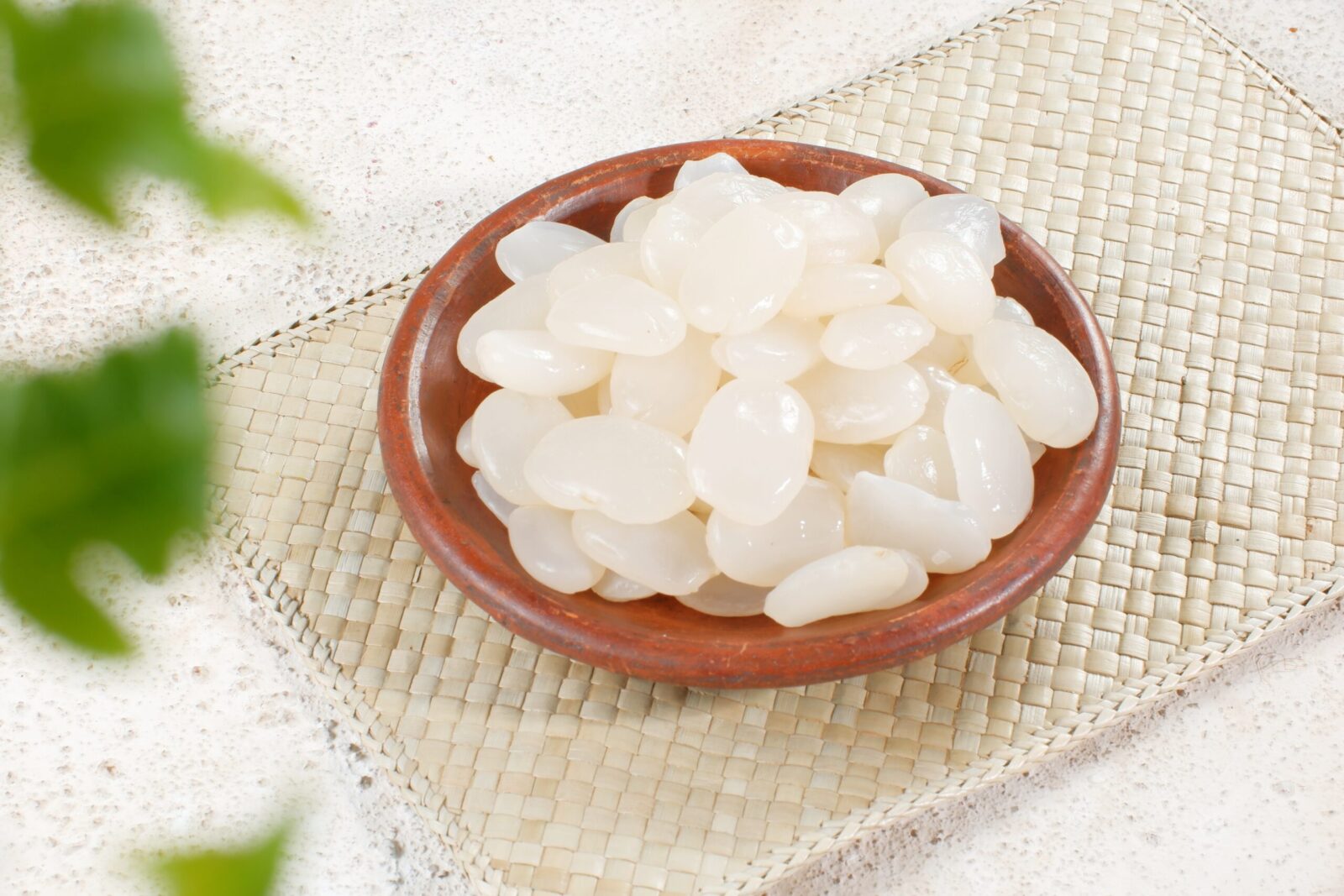Kaong, also known as “sugar palm fruit,” is a tropical delight that hails from the Philippines and other Southeast Asian countries. This exotic fruit has gained popularity not only for its sweet and unique taste but also for its versatility and nutritional benefits.
In this article, we will explore the Kaong plant, the sweet treasure it bears, its culinary and health-related uses, and the cultivation and harvesting process.
Introduction to Kaong (Arenga pinnata)
The Kaong, scientifically known as Arenga pinnata, is a palm tree species native to Southeast Asia.
It thrives in tropical and subtropical regions, particularly in the Philippines, Indonesia, Malaysia, and Thailand.
Kaong has a sturdy trunk that can reach heights of up to 20 meters. It features large, feathery fronds at the top, often growing in clusters.
The fruit of the Kaong plant is small, elongated, and encased in translucent, cream-colored, or occasionally red or green outer coverings, with a sweet and nutty flavor.
These distinctive physical characteristics make the Kaong plant a recognizable and valued part of Southeast Asian landscapes.

② Francisco Manuel Blanco (O.S.A.), Public domain, via Wikimedia Commons
Growing and Harvesting Kaong Trees
Cultivating and harvesting Kaong involves several distinct steps:
Step 1: Selecting the Right Location
Before you start planting your Kaong trees, it’s crucial to choose the right location. Here are some considerations to keep in mind:
- Climate – Kaong trees thrive in tropical and subtropical climates. Ensure your chosen location has a climate suitable for palm tree growth.
- Sunlight – Kaong trees need plenty of sunlight. Select a spot that receives full or partial sunlight throughout the day.
- Soil Quality – Well-draining, sandy loam soil is ideal for Kaong trees. Ensure the soil is rich in organic matter and has good water retention capacity.
- Spacing – Give your Kaong trees enough space to grow. They should be planted at least 15-20 feet apart to allow for their mature size.
Step 2: Planting Kaong Trees
Once you’ve chosen the right location, it’s time to plant your Kaong trees:
- Prepare the Soil – Clear the area of any weeds or debris. Ensure the soil is well-tilled and enriched with organic matter.
- Planting Depth – Dig a hole that is twice the size of the root ball. Place the tree in the hole, making sure the soil level matches the level of the tree’s root ball.
- Watering – Water the newly planted Kaong tree thoroughly. Continue to water regularly during the establishment phase.
Step 3: Nurturing the Palm Trees
To ensure healthy growth, you’ll need to nurture your Kaong trees:
- Watering – Kaong trees require consistent moisture, especially during dry spells. Water deeply but avoid waterlogging.
- Fertilizing – Use a balanced palm tree fertilizer to provide essential nutrients. Apply fertilizer according to the package instructions.
- Pruning – Prune dead or damaged fronds regularly to promote air circulation and healthy growth.
Step 4: Waiting for Maturity
Kaong trees take time to mature, so patience is key. It can take several years for your trees to produce their first bunches of fruit.
Continue to provide proper care and maintenance during this waiting period.
Step 5: Harvesting Kaong Bunches
Once your Kaong trees reach maturity, it’s time to enjoy the fruit of your labor:
- Ripe Bunches – Kaong bunches are typically ready for harvest when they turn yellow or orange and are easy to pull from the tree.
- Use Pruning Shears – Carefully cut the bunch from the tree using pruning shears to avoid damaging the palm.
Step 6: Removing the Outer Layer
After harvesting, you’ll need to remove the outer layer of the Kaong bunch:
- Peeling – Gently peel away the outer layer to reveal the sweet and tender Kaong seeds inside.

Step 7: Processing Kaong
The final step is processing the Kaong for various culinary uses:
- Rinse and Clean – Wash the Kaong seeds thoroughly to remove any excess sap or debris.
- Use in Recipes – Incorporate Kaong in your favorite dishes, desserts, and snacks for a delightful sweet flavor.
Kaong Fruit: A Sweet and Delectable Treat
Kaong fruit is characterized by its small, translucent, and elongated seeds.
The seeds are typically cream-colored but can also be found in red and green varieties, each with a slightly different flavor profile.
The sweetness of Kaong is what sets it apart from other tropical fruits. It has a sugary taste with a hint of nuttiness, making it a favorite ingredient in various culinary applications.
Kaong’s Culinary Uses
1. Desserts
Kaong’s sweet and chewy texture makes it a star in Filipino desserts, particularly in the beloved halo-halo.
This mixed dessert combines various sweet treats like crushed ice, beans, jellies, and leche flan, and the addition of Kaong adds a delightful contrast of flavor and texture.

2. Candies and Sweets
Kaong seeds are often preserved in sugar syrup, creating delightful candies and sweets with vibrant colors and a burst of sugary goodness.
These sweet treats are not only delicious but also visually appealing, making them a popular choice for snacks and gifts.

3. Salad
Kaong’s sweet and crunchy texture makes it a fantastic addition to fruit salads.
When combined with other tropical fruits like papaya, mango, and pineapple, it creates a refreshing and colorful salad that’s perfect for warm, sunny days.
The Nutritional Benefits of Kaong Fruit
Kaong is not only a sweet delight but also a nutritional powerhouse. Here’s a breakdown of its key components:
1. Rich in Vitamins
Kaong is a good source of vitamins, particularly vitamin C. This essential nutrient plays a crucial role in supporting the immune system, promoting healthy skin, and aiding in collagen production.
Including Kaong in your diet can be a tasty way to boost your daily vitamin intake.
2. Mineral Content
In addition to vitamins, Kaong also provides essential minerals such as potassium and iron. These minerals are vital for overall well-being:
- Potassium – Regulates blood pressure, supports heart health, and helps maintain proper muscle function.
- Iron – Prevents anemia and ensures the efficient transport of oxygen throughout your body.
3. Dietary Fiber
Kaong is a great source of dietary fiber. Fiber is beneficial for a variety of reasons, including:
- Better Digestion – Dietary fiber aids in digestion and helps prevent constipation.
- Satiety – It can help you feel full for longer, which is valuable for those looking to manage their weight and maintain a healthy diet.
4. Antioxidants
Kaong is rich in antioxidants, which are essential for safeguarding your health:
- Cell Protection – Antioxidants combat harmful free radicals, protecting your cells from damage.
- Overall Health – A diet rich in antioxidants may reduce the risk of chronic diseases and contribute to your overall well-being.
Here’s a table listing the vitamins and minerals found in Kaong fruit:
| Nutrient | Function and Benefits |
|---|---|
| Vitamin C | Immune support, healthy skin, collagen production |
| Potassium | Blood pressure regulation, heart health, muscle function |
| Iron | Anemia prevention, oxygen transport |
| Dietary Fiber | Improved digestion, increased satiety |
| Antioxidants | Cell protection, reduced risk of chronic diseases |
Incorporating Kaong into your diet can be a delicious way to enhance your nutrition and support your well-being.
Conclusion
Kaong, the sweet and versatile fruit from the sugar palm tree, is not only a delicious treat but also a nutritious addition to various dishes.
Its unique flavor and chewy texture make it a favorite ingredient in Filipino and Southeast Asian cuisine
Whether enjoyed in desserts, salads, or sweets, Kaong is a tropical delight that brings a touch of the exotic to your plate, while also offering valuable health benefits.
So, if you ever get the chance to savor this delectable fruit, be sure to give it a try.
Also Read: 10 Most Common Crops in the Philippines: A Comprehensive Overview
Well, what do you think about the article?
Did you enjoy reading “Kaong: The Sweet Sugar Palm Fruit, Growing Tips, And Nutritional Benefits“? We really hope that you have enjoyed this article.
If you have any thoughts or comments about this post, please feel free to share them in the comment section below. We appreciate your feedback and would be glad to hear from you.
To see more content like this check the gardening section of Money For My Beer.

Lara is a freelance content writer and a cat mom to three furbabies, Mizu, Haru and Sora.
She graduated with a Bachelor’s Degree in Architecture and is a registered and licensed Architect. Aside from writing, she is fond of growing cacti and succulents and is a DIY type of girl.
During her free time, she engages herself in water-colouring and crocheting, while catching-up with an old tv series she just discovered. Lara loves to explore new places, but most of the time stays in her hometown province, reading historical romance novels over a cup of coffee – or matcha.

